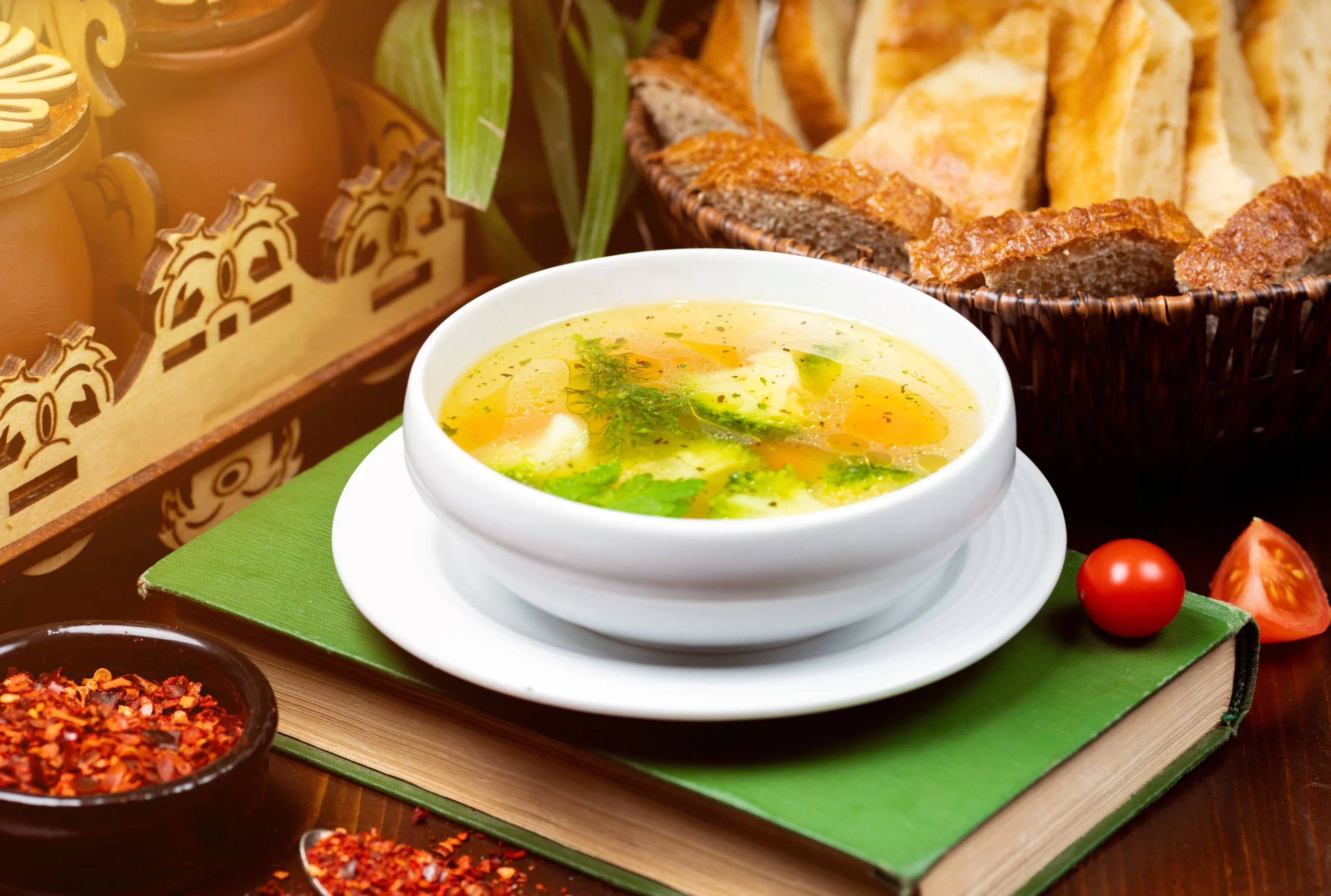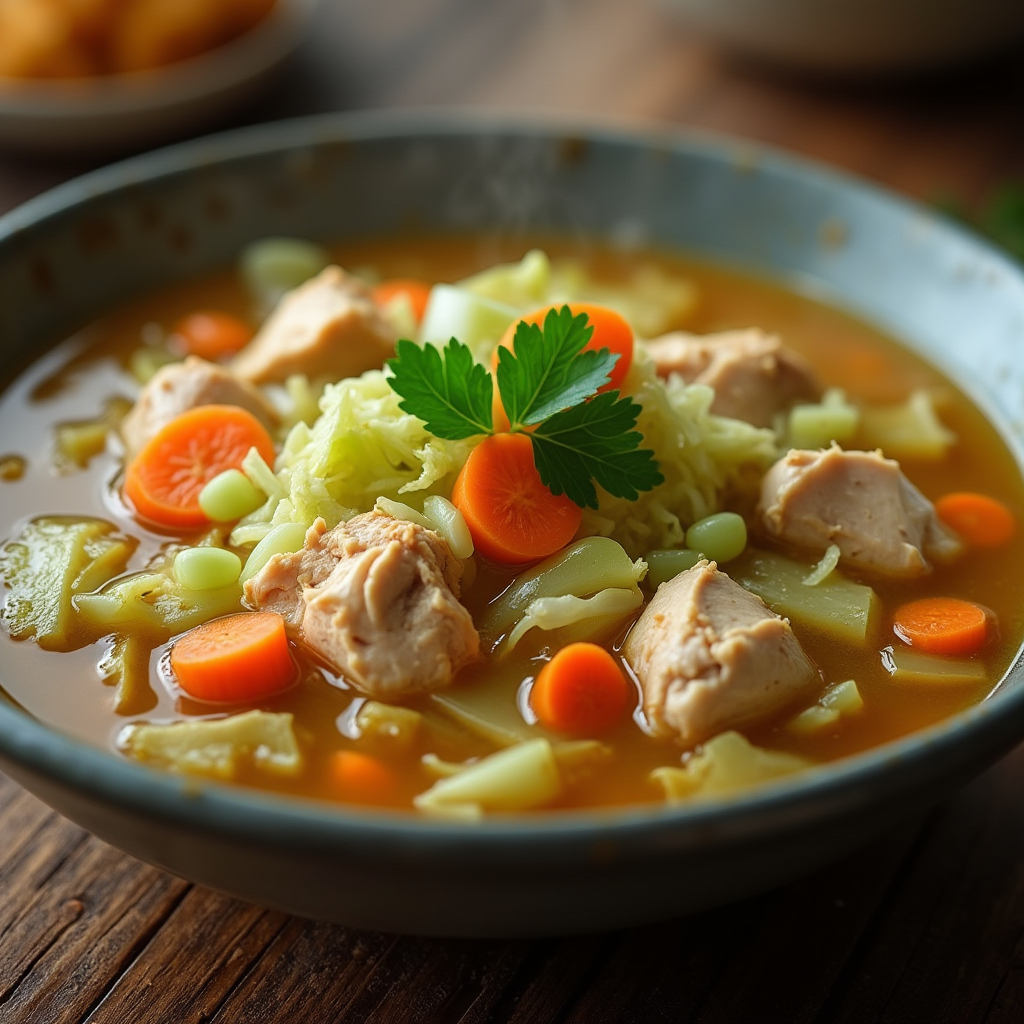How to make a simple chicken cabbage soup recipe

Growing up in my grandmother’s kitchen, the smell of chicken cabbage soup was always a sign of comfort and warmth. Watching her chop vegetables and simmer the broth is a memory that has stayed with me. It has inspired many meals in my own home. This soup is more than just food—it’s a link to family traditions and nourishing cooking.
Chicken cabbage soup is the ultimate comfort food. It turns simple ingredients into a tasty, healthy meal. Whether you’re fighting a cold, looking for a warm dinner, or want a versatile soup recipe, this dish is perfect. It’s easy to make and full of good stuff for you.
Table of Contents
Understanding the Appeal of Traditional Chicken Cabbage Soup
Chicken cabbage soup is a beloved dish that has warmed many kitchens for years. It connects us to old culinary traditions from around the world. It’s not just a meal; it’s a comforting experience that goes beyond time and culture.
Cultural Roots and Significance
The story of this soup is a rich mix of culinary heritage. It has been adopted by many cultures, each adding their own twist. From Eastern Europe to American homes, it symbolizes:
- A symbol of home and family traditions
- An affordable and hearty meal for large families
- A way to preserve seasonal vegetables
Nutritional Powerhouse
Chicken cabbage soup is also a nutritional powerhouse. It combines lean protein with vegetables for a balanced meal. Its health benefits include:
- High protein content from chicken
- Rich in vitamins and minerals from cabbage
- Low-calorie option for weight management
Timeless Comfort Food Appeal
This soup’s lasting appeal comes from its simple yet rich flavors. It’s more than just food; it’s a way to connect with our past. It brings warmth and nostalgia with every spoonful.
“A good soup is the foundation of happiness” – Ancient Culinary Wisdom
Essential Ingredients for Your Perfect Soup
Making a tasty chicken cabbage soup starts with picking the right ingredients. Your meal becomes a hearty delight with fresh, quality parts. These turn simple cooking into something special.
For a great chicken cabbage soup, choose your ingredients wisely. The right ones will give your soup its flavor and quality.
- Chicken: Pick bone-in, skinless chicken thighs or breasts for the best taste
- Fresh green cabbage, preferably crisp and firm
- Aromatic vegetables like onions, carrots, and celery
- High-quality chicken broth or stock
- Fresh herbs such as parsley or thyme
When picking chicken, go for organic or free-range. They taste better and are healthier. Fresh veggies are key to making your soup warm and comforting.
| Ingredient | Quality Recommendation | Flavor Impact |
| Chicken | Organic, free-range | Rich, deep flavor |
| Cabbage | Fresh, crisp green | Sweet, tender texture |
| Herbs | Fresh, not dried | Bright, aromatic notes |
Your chicken cabbage soup will be amazing with top-notch ingredients. Fresh, seasonal stuff and the right proteins make it unforgettable and cozy.
Kitchen Equipment You’ll Need
Creating tasty winter warmers like chicken cabbage soup needs the right tools. The right equipment makes cooking easier and more fun. With a few key items, you can make soups that warm you up inside.
Essential Cookware and Tools
Start your soup-making journey by picking the right gear. Here are the must-haves for making tasty soups:
- Large Pot or Dutch Oven: A 6-8 quart pot with a heavy bottom for even heat distribution
- Sharp Chef’s Knife for precise ingredient chopping
- Cutting Board
- Wooden Spoon or Silicone Spatula
- Measuring Cups and Spoons
Optional Equipment for Enhanced Preparation
These tools are not necessary but can make your soup prep better:
| Equipment | Benefit |
| Immersion Blender | Create smooth, creamy textures instantly |
| Food Processor | Quick vegetable chopping and preparation |
| Kitchen Scale | Precise ingredient measurements |
| Slow Cooker | Alternative cooking method for soup recipes |
Good kitchen equipment makes your soups delicious and consistent. Pick tools that match your cooking style and budget. Then, you can easily make comforting winter warmers.
Preparing Your Fresh Ingredients
Starting to make chicken cabbage soup means getting your ingredients ready. It’s all about picking and preparing fresh ingredients carefully. The way you chop vegetables and handle chicken can make your broth truly special.
Before cooking, collect all your ingredients. Follow these key steps for preparation:
- Wash all vegetables thoroughly under cold running water
- Pat vegetables dry with clean kitchen towels
- Use sharp knives for precise chopping
- Cut vegetables into uniform sizes for consistent cooking
Preparing chicken is also crucial. Rinse it under cold water and dry it with paper towels. Trim any excess fat or unwanted parts to make sure your chicken is clean and of high quality.
Here are some tips for sauteed vegetables:
- Chop vegetables into similar-sized pieces
- Use a high-quality cooking oil with a high smoke point
- Heat your pan before adding vegetables
- Avoid overcrowding the pan to ensure proper caramelization
Good ingredient preparation is key to a tasty chicken cabbage soup. Take your time and be thorough. Your hard work will pay off with a meal that’s both healthy and delicious.
Step-by-Step Chicken Cabbage Soup Instructions
Making a tasty chicken cabbage soup needs careful steps. This guide will show you how to make a warm and flavorful broth. It will make your taste buds happy.
Preparing the Chicken Base
First, pick the best chicken for your soup. You should:
- Choose bone-in chicken pieces for richer flavor
- Trim excess fat and skin
- Cut chicken into bite-sized chunks
Start by heating olive oil in a large pot. Brown the chicken pieces until they’re golden. This step adds a deeper flavor to your broth.
Adding Vegetables and Seasonings
For a great chicken cabbage soup, focus on layers of flavor. Sauteed vegetables are key:
- Dice onions, carrots, and celery
- Sautee vegetables until they’re soft and fragrant
- Add minced garlic for extra depth
Add herbs like thyme, rosemary, and bay leaves. Salt and pepper are crucial for bringing out the natural flavors of your ingredients.
Simmering and Final Touches
Slowly simmer your soup to blend flavors. Add chopped cabbage towards the end to keep its texture. Let it cook on low heat for 30-40 minutes, stirring now and then.
Taste and adjust seasonings as needed. Your homemade chicken cabbage soup is now ready to serve hot and enjoy!
Tips for Achieving the Perfect Broth Consistency
Making the perfect broth for your chicken cabbage soup is all about technique and detail. It’s crucial for a balanced flavor and texture. Professional chefs agree that the broth’s consistency is what makes a soup.
First, understand what affects your soup’s thickness:
- Liquid-to-solid ingredient ratio
- Cooking time and temperature
- Thickening agents
Here are some expert tips to control your broth’s consistency:
- Reduce naturally: Simmer your soup uncovered to let excess liquid evaporate
- Use cornstarch or flour as a thickener
- Add pureed vegetables for natural thickening
If your soup is too thin, add warm chicken stock slowly. For thickening, try these methods:
| Method | Best For | Technique |
| Cornstarch slurry | Quick thickening | Mix 1 tbsp cornstarch with cold water, stir into soup |
| Roux | Rich, creamy texture | Cook equal parts butter and flour before adding to soup |
| Vegetable puree | Natural thickening | Blend cooked potatoes or carrots into broth |
Remember, patience is key in perfecting your soup recipe. Taste and adjust your broth often while cooking. This way, you’ll get a delicious, hearty meal every time.
Variations and Customization Options


Creating delicious soup recipes doesn’t mean you’re limited to a single approach. Winter warmers like chicken cabbage soup offer incredible flexibility for home-cooked delights. Experimenting with different ingredients can transform your basic recipe into a personalized culinary experience.
Spice Level Adjustments
Tailoring the soup’s heat to your taste preferences is simple. Consider these spice modification strategies:
- Mild: Use black pepper and minimal cayenne
- Medium: Add red pepper flakes or jalapeño
- Hot: Incorporate habanero peppers or sriracha sauce
Vegetable Substitutions
Your winter warmers can adapt to seasonal availability or personal preferences. Try these vegetable alternatives:
| Original Vegetable | Potential Substitute |
| Cabbage | Kale, Bok Choy |
| Carrots | Parsnips, Turnips |
| Celery | Fennel, Leeks |
Alternative Protein Options
Home-cooked delights can showcase diverse protein choices beyond traditional chicken. Consider these alternatives:
- Vegetarian Option: Tofu or tempeh
- Seafood Variation: Shrimp or white fish
- Red Meat Alternative: Lean beef or lamb
Remember, soup recipes are versatile canvases for culinary creativity. Don’t be afraid to experiment and make the recipe truly your own!
Storage and Reheating Guidelines
Keeping your chicken cabbage soup fresh is key. You need to store and reheat it right. This way, your meal stays safe and delicious for more servings.
Here’s how to store your soup:
- Cool the soup completely before storing
- Use airtight containers for refrigeration
- Refrigerate within 2 hours of cooking
For the fridge, your soup stays good for 3-4 days. Always use clean tools to avoid germs.
Freezing is great for longer storage:
- Let soup cool to room temperature
- Transfer to freezer-safe containers
- Leave 1-inch space at the top for expansion
- Label with date and contents
Here’s how to reheat safely:
- Thaw frozen soup in the refrigerator overnight
- Reheat to an internal temperature of 165°F
- Stir occasionally to distribute heat evenly
- Consume within 24 hours after reheating
Pro tip: If your soup is too thick after chilling, add a bit of water or broth. This will make it the right consistency again.
Serving Suggestions and Pairings
Make your chicken cabbage soup special with the right sides. These pairings can make a simple meal into a memorable event. They will impress both your family and guests.
Perfect Side Dishes
Choose these tasty sides to go with your soup. They add to the rustic feel and make your meal complete:
- Crusty artisan bread for dipping
- Homemade garlic herb focaccia
- Crisp green salad with light vinaigrette
- Buttered egg noodles
- Roasted root vegetables
Elegant Garnishing Techniques
Enhance your soup with these elegant garnishes:
- Sprinkle fresh chopped parsley
- Add a dollop of sour cream
- Drizzle high-quality olive oil
- Crumble crispy bacon bits
- Scatter thinly sliced green onions
| Garnish | Flavor Profile | Best Paired With |
| Fresh Herbs | Bright, Fresh | Light Chicken Broth |
| Crispy Bacon | Smoky, Rich | Hearty Winter Soup |
| Sour Cream | Creamy, Tangy | Spicy Soup Variations |
Each garnish adds something special to your soup. It turns a simple meal into an extraordinary culinary experience. Try different combinations to find your favorite.
Troubleshooting Common Issues
Making the perfect soup can be tough, even for experts. When you’re cooking a healthy dish like chicken cabbage soup, you might face some common problems. These can affect how your soup turns out.
Managing salt is very important in soup making. If you’ve added too much salt, don’t worry. Here are some fast ways to fix it:
- Add a peeled potato to soak up extra salt
- Mix in unsalted chicken stock to dilute
- Add more veggies to balance the taste
The broth’s consistency is crucial. If it’s too thin, your soup might not be what you hoped for. Professional chefs suggest these fixes:
- Use cornstarch or flour to thicken
- Blend some veggies into the broth
- Let it simmer longer to reduce liquid
Undercooked veggies can spoil a good soup. To cook evenly, cut veggies the same size. Add them at the right time during cooking.
Keeping the temperature right is important. High heat can make proteins tough and veggies mushy. Always keep the heat low to keep your soup’s texture and taste good.
“Patience transforms a good soup into a great one.” – Professional Chef Recommendation
Conclusion
Making a tasty chicken cabbage soup is more than a recipe. It’s about creating a cozy, comforting moment for your family. Your homemade soup is a simple yet powerful tradition that turns simple ingredients into a nourishing meal.
This comfort food is very flexible. You can try different spices, veggies, and proteins to make it your own. Each change tells a story, shows your cooking style, and adds a personal touch to a classic dish.
Cooking is all about exploring and enjoying. As you get better at making soup, you’ll find new ways to mix flavors. Your kitchen becomes a place of creativity, where every soup is a new adventure to share with your loved ones.
Enjoy the journey, trust your taste, and feel the joy of making a hearty meal. Your cooking adventure has just started, and this soup is the perfect beginning.
FAQ
How long does it take to make chicken cabbage soup?
It takes about 45-60 minutes to make chicken cabbage soup. You’ll spend 15-20 minutes preparing it. Then, it cooks for 30-40 minutes, depending on your chopping and the recipe.
Can I make this soup ahead of time?
Yes, you can! Chicken cabbage soup tastes better the next day. You can make it ahead and keep it in the fridge for 3-4 days or freeze it for 3 months. Just cool it down before storing and reheat gently.
Is chicken cabbage soup healthy?
Absolutely! It’s full of lean protein, fiber, and vitamins. It’s low in calories but packed with nutrients. It’s great for your health and wellness.
Can I make this soup vegetarian?
Certainly! Replace chicken with tofu, tempeh, or beans for a vegetarian version. Use vegetable broth for a rich flavor.
What are the best vegetables to add to chicken cabbage soup?
Add carrots, celery, onions, potatoes, and bell peppers for extra nutrition and flavor. Use fresh, seasonal veggies for the best taste.
How can I make my chicken cabbage soup more filling?
Add whole grains like barley or quinoa, or extra protein like beans or lentils. Serve with crusty bread or rice for more filling.
What type of chicken works best for this soup?
Use boneless, skinless chicken breasts or thighs. Breasts are leaner, while thighs are more flavorful. Leftover roasted chicken adds convenience and flavor.
How can I adjust the soup’s spice level?
Add red pepper flakes, hot sauce, or cayenne for heat. Start with a little and adjust to taste. For a milder flavor, use herbs like thyme or parsley.
